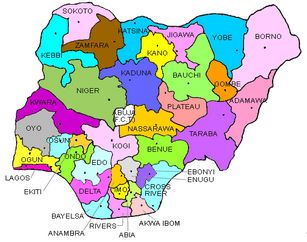
KEY DATA
• Region:West Africa
• Population:140,003,542 as at 2006, estimated by The National Population Commission (NPC)
• Area Total:923,770 km2
• Area Land:910,770 km 2
• Coast Line:853 km
• Capital:Abuja
• Climate:Varies: equatorial in south, tropical in center, arid in north
• Major Languages: o English (official) o Hausa o Yoruba o Ibo
• Currency:1 Naira (?) = 100 Kobo
• National Day:Independence Day, 1 October (1960)
GOVERNMENT: Three-tier structure - A Federal Government, 36 State Governments, 768 Local Government Administrations and 6 Area Councils of the Federal Capital Territory of Abuja.
MAIN RELIGIONS: Traditional Beliefs, Christianity, Islam
MAIN COMMERCIAL/INDUSTRIAL CITIES: Lagos, Onitsha, Kano, Ibadan, Port Harcourt, Aba, Maiduguri, Jos, Kaduna, Warri, Benin, Calabar.
MAJOR INDUSTRIAL COMPLEXES: Refineries and Petro-Chemicals: Kaduna, Warri, Port Harcourt, Eleme.
Iron and Steel: Ajaokuta, Warri, Oshogbo, Katsina, Jos.
Fertilizer: Onne- Port Harcourt, Kaduna, Minna, Kano
Liquified Natural Gas : Bonny Aluminium Smelter: Ikot Abasi, Port Harcourt
MAIN PORTS: Lagos (Apapa, Tin-can Island), Warri, Port Harcourt, Onne Deep Sea and Hub Port, Calabar (EPZ)
MAIN AIRPORTS: Lagos, Kano, Port Harcourt, Abuja, Enugu, Kaduna, Maiduguri, Ilorin, Jos, Owerri, Calabar, Yola, Sokoto
ROAD NETWORK: Over 15,000 km of intercity all weather paved roads, including dual carriage express trunks.
RAILWAYS: 2 main lines (South-West to North-East; South-East to North-West) inter-linked and terminatory at Lagos, Port Harcourt, Kaura Namoda, Maiduguri and Nguru. Major junctions at Kaduna, Kafanchan, Zaria. Gauge: 1067mm; Total length 3505 route km.
ABOUT NIGERIA
GEOGRAPHY
Nigeria is situated in the West African region and lies between longitudes 3 degrees and 14 degrees and latitudes 4 degrees and 14 degrees. It has a land mass of 923,768 sq.km. It is bordered to the north by the Republics of Niger and chad; it shares borders to the west with the Republic of Benin, while the Republic of Cameroun shares the eastern borders right down to the shores of the Atlantic Ocean which forms the southern limits of Nigerian Territory. The 800km of coastline confers on the country the potentials of a maritime power. Land is in abundance in Nigeria for agricultural, industrial and commercial activities.At its widest, Nigeria measures about 1,200 km from east to west and about 1,050 km from north to south. The country's topography ranges from lowlands along the coast and in the lower Niger Valley to high plateaus in the north and mountains along the eastern border. Much of the country is laced with productive rivers. Nigeria's ecology varies from tropical forest in the south to dry savanna in the far north, yielding a diverse mix of plant and animal life.
The broad, mostly level valleys of the Niger and Benue rivers form Nigeria's largest physical region. The Niger enters the country from the northwest, the Benue from the northeast; the two rivers join in Lokoja in the south central region and continue south, where they empty into the Atlantic at the Niger Delta. Together, they form the shape of a Y. Population densities and agricultural development are generally lower in the Niger and Benue valleys than in other areas. North of the Niger Valley are the high plains of Hausaland, an area of relatively level topography averaging about 800 m above sea level, with isolated granite outcroppings.The Jos Plateau, located close to Nigeria's geographic center, rises steeply above the surrounding plains to an average elevation of about 1,300 m. To the northeast, the plains of Hausaland grade into the basin of Lake Chad; the area is characterized by somewhat lower elevations, level terrain, and sandy soils. To the northwest, the high plains descend into the Sokoto lowland.
Southwest of the Niger Valley (on the left side of the Y) lies the comparatively rugged terrain of the Yoruba highlands. Between the highlands and the ocean runs a coastal plain averaging 80 km in width from the border of Benin to the Niger Delta.The delta, which lies at the base of the Y and separates the southwestern coast from the southeastern coast, is 36,000 sq km of low-lying, swampy terrain and multiple channels through which the waters of the great river empty into the ocean. Several of the delta's channels and some of the inshore lagoons can be navigated.
Southeastern coastal Nigeria (to the right of the Y) consists of low sedimentary plains that are essentially an extension of the southwestern coastal plains. In all, the Atlantic coastline extends for 850 km. It is marked by a series of sandbars, backed by lagoons of brackish water that support the growth of mangroves. Large parts of Africa's Bight of Benin and Bight of Biafra fall along the coast. Because of the Guinea Current, which transports and deposits large amounts of sand, the coastline is quite straight and has few good natural harbors. The harbors that do exist must be constantly dredged to remove deposited sand.
Inland from the southeastern coast are progressively higher regions. In some areas, such as the Udi Hills northwest of Enugu, escarpments have been formed by dipping rock strata. Farther east, along Nigeria's border with Cameroon, lie the eastern highlands, made of several distinct ranges and plateaus, including the Mandara Mountains, the Shebeshi Mountains, the Alantika Mountains, and the Mambila Mountains. In the Shebeshi is Dimlang (Vogel Peak), which at 2,042 m is Nigeria's highest point.